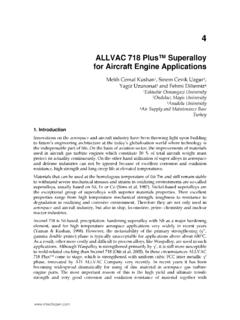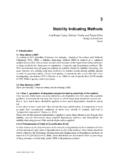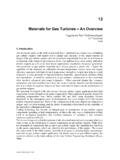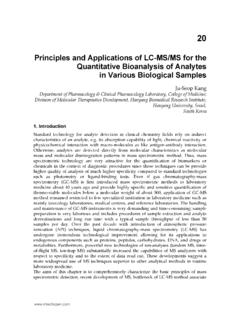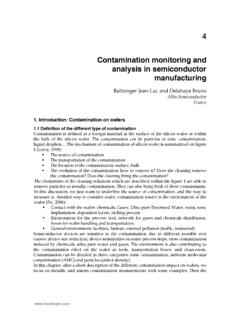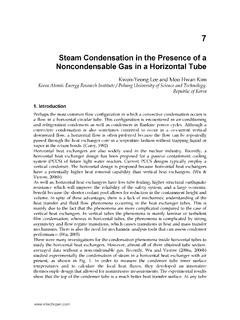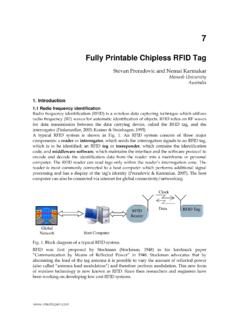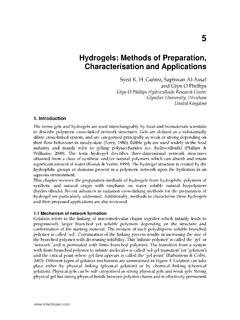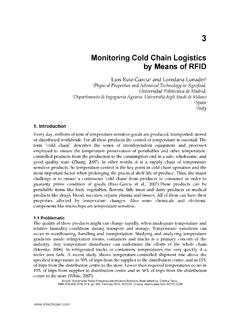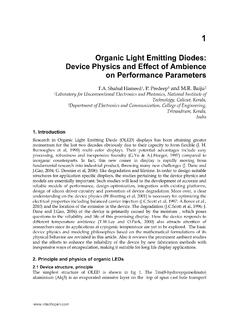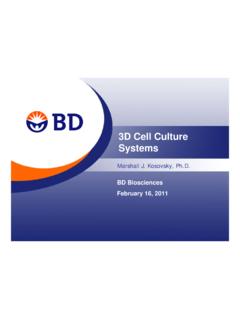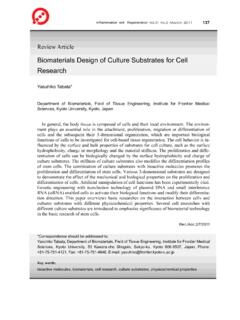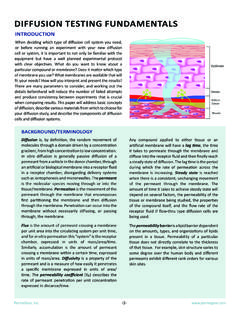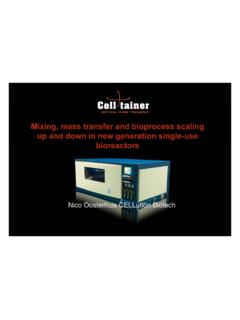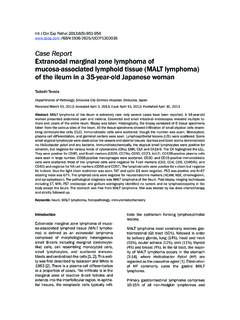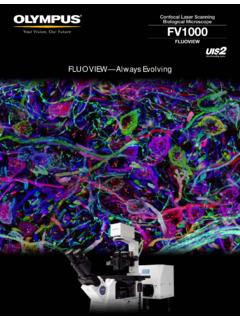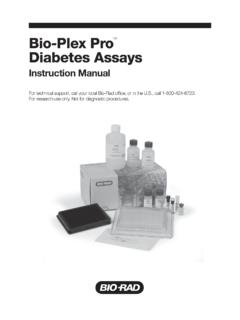Transcription of Cartilage Regeneration from Bone Marrow Cells Using …
1 11. Cartilage Regeneration from bone Marrow Cells Using RWV Bioreactor and Its Automation System for Clinical Application Toshimasa Uemura1, Masanori Nishi1, Kunitomo Aoki2 and Takashi Tsumura3. 1 National Institute of Advanced Industrial Science and Technology (AIST), Ibaraki, 2 Industrial Technology Institute of Ibaraki Prefecture, Higashi Ibaraki, Ibaraki, 3 JTEC Corporation, Kobe, Hyogo Japan 1. Introduction Articular Cartilage covers the end of bones in joints and determines the load-bearing characteristics and mobility of joints. It has a thin, smooth, low friction surface with a remarkable resiliency to compressive forces. In general, chondrocytes occupy lacunae in the matrix, and produce cartilaginous ECM (extracellular matrix), which consists of type II. collagen (13%), proteoglycans (7%), and water (80%). Cartilage defects result from aging, joint injury, and developmental disorders, causing joint pain and loss of mobility.
2 Articular Cartilage is metabolically active, however, the chondrocytes have a slow turnover rate. Thus, articular Cartilage might suffer progressive damage and degeneration with a limited spontaneous repair capability. Total joint arthroplasty is the final choice of treatment, however, it is not suitable for young patients because of the limited life span of the artificial joint. Marrow -stimulating techniques such as microfracturing, multiple drilling, mosaicplasty and autologous chondrocyte implantation are clinically available for young patients, but have some limitations (Ikada, 2006). Marrow - stimulating techniques result in a fibrocartilage with less mechanical strength than hyaline Cartilage and only limited repair capacity. The major problems with mosaicplasty are a limited availability of autologous tissue and donor site morbidity, the destruction of healthy non-weight-bearing tissue to repair diseased tissue. Autologous chondrocyte transplantation with a periosteal graft has shown encouraging results, however, predictability and reliability are still questionable.
3 Ochi et al. (2002) showed a clinical advantage of transplanting autologous chondrocytes cultured in collagen gel for the treatment of full-thickness defects of Cartilage in 28 knees over a minimum period of 25 months. Arthroscopic assessment indicated that 26 knees (93%) had a good or excellent outcome. Wakitani et al. (2002) applied cell transplantation to repair human articular Cartilage defects in osteoarthritis knee joints. The study group comprised 24 patients with knee OA. Adherent Cells expanded from bone Marrow aspirates were embedded in collagen gel and transplanted into the articular Cartilage defects of 12. 218 Tissue Engineering for Tissue and Organ Regeneration knees, with the other 12 knees serving as cell-free controls. Arthroscopic and histological grading scores were better in the cell-transplanted group than cell-free group. In spite of these successful clinical results to expand the clinical treatment of Cartilage diseases, we need to establish a three dimensional culture technique for regenerating large Cartilage tissue in vitro.
4 One solution is to use an RWV (rotating wall vessel ) bioreactor. 2. Regeneration of cartilaginous tissue from rabbit bone Marrow Cells under three dimensional culture by RWV bioreactor RWV (rotating wall vessel) bioreactor Recently, three-dimensional cell culture techniques have attracted much attention among not only cell and developmental biologists but also clinicians who have an interest in tissue engineering (Abbott, 2003). The limitations of two-dimensional culture Using conventional flasks or dishes are becoming clear. In the field of tissue engineering, the chondrocyte cell is a typical example of the major difference between a flat layer of Cells and a complex, three- dimensional tissue (Holtzer, 1960; Passaretti et al., 2001). Matured chondrocytes in the two- dimensional condition dedifferentiated without maintaining their phenotype and lost their original phenotype after four rounds of subculture. Clinically, a method of regenerating Cartilage tissue needs to be established to treat diseases such as osteoarthritis.
5 Thus, the development of a cell culture system for the growth of three-dimensional Cartilage is important. However, problems such as necrosis due to high-density cell culture and shear stress have not yet been solved Using conventional stirred fermentors. We examined the use of a rotating wall vessel (RWV) bioreactor that simulates a microgravity environment with low shear stress for Cartilage tissue Regeneration ( ). This bioreactor generates stress by the horizontal rotation of a cylindrical vessel equipped with a gas exchange membrane. The RWV bioreactor compensates for the effect of gravity, resulting in homogenous cell growth and differentiation without sinking, and Cells aggregate and form a three-dimensional tissue. The advantage of Using an RWV bioreactor for tissue formation was first reviewed by Unsworth and Lelkes (1998), who discussed the benefits of growing tissues in microgravity and simulated microgravity. The formation of tissue by, for example, endothelial Cells (Sanfold et al.)
6 , 2002), colon carcinoma cell lines (Goodwin et al., 1992), ovarian cancer Cells (Goodwin et al., 1997), osteoblasts (Qiu et al., 1999), and erythroid Cells (Sytkowski and Davis, 2001), has been reported. In particular, the RWV bioreactor has been shown to stimulate chondrogenesis (Baker and Goodwin, 1997; Duke et al., 1993). Moreover, a comparison of chondrocyte Cells cultured in rotating bioreactors in space (Mir space station). and on earth was reported by Freed et al. (1997a). They performed rotating cultures of bovine chondrocytes in polyglycolic acid (PGA) scaffolds and concluded that the culture on earth produced Cartilage tissues closer to the natural form than that in space. In this case, the culture period for obtaining tissue was 7 months. Very recently, the chondrogenesis of human Cartilage by an RWV bioreactor has been reported (Marlovits et al., 2003). Good quality Cartilage tissue was formed by rotating culture from aged human articular Cartilage after 90 days of cultivation.
7 In spite of numerous studies on the formation of Cartilage tissue from chondrocytes, our report (Ohyabu et al., 2006) was the first on the production of cartilaginous tissue from bone Marrow -derived Cells by rotating culture. A three- dimensional cell culture technique was established for the construction of large and homogenous Cartilage tissues without a scaffold Using bone Marrow -derived Cells and an RWV bioreactor. Cartilage Regeneration from bone Marrow Cells Using RWV Bioreactor and Its Automation System for Clinical Application 219. Fig. 1. RWV Bioreactor Fig. 2. Time-dependence of the rotation speed Regeneration of Cartilage tissue in vitro Using rabbit bone Marrow Cells and an RWV bioreactor bone Marrow Cells were collected from the femora of six 10-day-old Japanese white rabbits and cultured in a standard medium consisting of Dulbecco's Modified Eagle's Medium(DMEM) containing 10% fetal bovine serum for 3 weeks. The Cells were resuspended in a chondrogenic differentiation medium comprising DMEM containing 10%.
8 FBS and 10 ng/mL of TGF- (Johnstone et al., 1998) and seeded in the discoidal vessels of an RWV reactor in a CO2 incubator. A rotatory culture was performed for 4 weeks. The rotation speed was adjusted manually in order to keep cell aggregates freely suspended within the vessel. As a control, a tube culture was performed, a kind of three dimensional culture technique developed by Holtzer and Manning (Holtzer, 1960; Manning and Bonner, 1967). and established by Johnstone et al. (1998). After the rotating culture in the RWV vessel and 220 Tissue Engineering for Tissue and Organ Regeneration static culture in the conical tube, the aggregates were harvested and prepared for histochemical and biochemical analysis. Fig. 3. In vitro Cartilage tissue Regeneration from rabbit bone Marrow Cells Using RWV. bioreactor The rotation speed of the RWV was adjusted manually to prevent the cell aggregates from sinking in the RWV vessel. The speed was varied between 11 and 25 rpm and increased steadily for 28 days ( ).
9 The change in speed originated from the steady increase in the mass of tissue formed in the vessel. Figure 3 shows images of the tissue formed in the RWV. vessel and in the 15-mL conical tube after 1 and 4 weeks of culture. The tissues are of a cylindrical shape. The size (height/diameter) of the tissue in the RWV vessel was cm at 1 week; cm at 2 weeks; and at 4 weeks. This kind of single tissue formed in the reactor reproducibly in the same experimental conditions. By contrast, the tissue formed in the 15-mL conical tube was smaller: cm at 1 week; cm at 2 weeks; and cm at 4 weeks. The qualities of the tissues as Cartilage were evaluated by histochemical methods including immunostaining of collagen type I and collagen type II and safranin-O and toluidine blue staining( ). The staining of collagen type II was more intense in the RWV than tube culture The results of safranin-O and toluidine blue staining are clearer as shown in Figure 4c and d.
10 The time course of safranin- O and toluidine blue staining in the tissues formed in the tubes shows that the tissue gradually became chondrogenic. However, this change occurred faster in the RWV tissues. Even at 1 week, chondrogenesis occurred in the RWV tissues, but no sign of chondrogenesis was detected in the tissues in the tubes. At 2 weeks, the difference between the two was clearer, and at 4 weeks, chondrogenesis of the RWV tissues was confirmed by the strong and homogeneous matachromasy of safranin-O staining. Comparing the results of safranin-O. staining, the RWV tissue at 1 week appeared to be in a similar stage of differentiation as the tube tissue at 4 weeks. In conclusion, we succeeded in the rapid Regeneration of three- dimensional large and homogeneous cartilaginous tissue from rabbit bone Marrow Cells without a scaffold Using a RWV bioreactor. bone Marrow Cells cultured for 3 weeks were resuspended and cultured for 4 weeks in the chondrogenic medium within the vessel.
